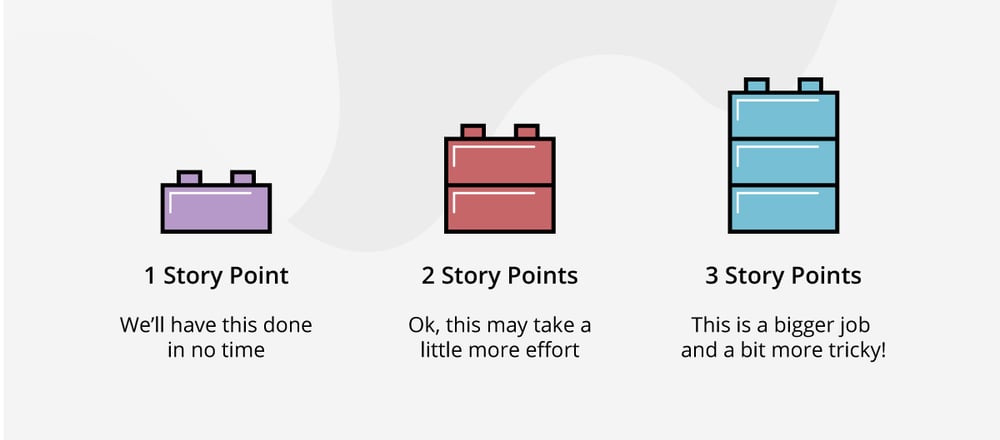If you’ve landed here, you may be questioning what "story points" are exactly and how they work in practice. Although they are the most popular way to estimate effort and associated timelines in sprint planning and estimation, story points can be misinterpreted if not understood clearly with a thorough definition.
| In project management, story points, or effort points as they are also known, are units of measure used to estimate the effort required to complete tasks within a project. |
Story points are typically assigned by the project manager or team leader and can be used to track progress and predict project completion time frames. Keep reading to learn more about how story points work and how they can be helpful in ensuring that work gets delivered on time.
Story points and their role
Story points (AKA effort points) refer to a concept commonly used within the Scrum Framework and help provide an estimate of how long a project is anticipated to take. A project will consist of one or more user stories, and these user stories are broken down into manageable tasks that are assigned story points in how long it will take to complete.
Story points are traditionally assigned using the Fibonacci numbering system, where each task is assigned a number 1-13 as an estimation relative to other tasks. These estimates, while linked to timescale, refer to the overall size, scope, or complexity of the task at hand. By comparing story points against estimated time frames and actual completion times for similar tasks, teams can gauge their progress towards a project deadline more accurately and consistently.
How to estimate story points accurately
Accurately estimating story points is an important part of maintaining project momentum and staying on schedule.
The best way to ensure accuracy is for the team involved to be realistic about the abilities of the collective team, the resources available to them, and their capacity for dedication to each task. Each member should provide as much insight as possible into the difficulty/complexity of each task when ascertaining what story points particular tasks will comprise of. It is also essential to bear in mind that estimations are never perfect as it is impossible to account for contingent variables, so expect to make adjustments in future iterations of similar tasks.
Story points should also have a timeline attached that all parties have visibility of and adhere to, to ensure progress is made in a timely fashion, with regular check-ins held between project managers and team members. Without such collaboration, team members may lose sight of the big picture.
Successfully estimating story points requires consistent support from all levels of management to keep team morale high and to ensure the team remains motivated throughout the process.
Common mistakes when estimating story points
While experience can be a valuable guide, it is always prudent not to rely too heavily on estimates based on past accomplishments as every task and every project is unique within its own context and it is important to ensure that the estimates accurately reflect the scope of each new situation.
Another common mistake people make is failing to take into account unexpected issues such as scope creep or unforeseen technical problems. It's important to consider these potential risks when making an estimate and build in buffer time so that you don't end up with insufficient hours assigned to a project.
Different members of the team with varying skill sets and experience will naturally complete a task in different amounts of time from each other. A very experienced member of the team with advanced knowledge would quite likely finish a task in a shorter amount of time than a new starter. One pitfall is assigning story points based on an individual’s expertise. The story points should be assigned consistently, whether the experienced member or the new starter completes the task – it is a value of the team’s general effort. It may be that when it comes to taking on the task, the experienced member who was assigned is now no longer available and somebody else now must complete it. If the story points are assigned based on an individual’s capability rather than a blanket estimate of any of the team, the team would run into a delivery time issue.
One last mistake made is simply that many teams underestimate how long a story point task will take to complete. Story points are meant to provide a realistic view of how much time each task requires, and it is important to ensure that each point estimation represents an accurate amount of work.
Story points at Struto
At Struto, we use story points for all our client projects, this is how it looks when we build a custom website for a client.
The development team starts by gathering all the requirements for the website – called scoping, and then uses the story points model to estimate how much work it will take to finish the site.
The process breaks down each requirement into individual tasks - from designing layout and colour schemes to writing code - and then assigns story points to each task based on its difficulty. This allows the team to easily track progress as well as make predictions about when the project will be complete. By combining an analysis of task complexities with an accurate measure of resources available, the team is able to use story points to create achievable timelines for their projects and manage the client’s expectations.

In conclusion...
When used correctly, story points can help teams estimate workloads accurately, plan projects effectively, and avoid common mistakes. It is important to consider the complexity of the task, the dependencies involved, and the team's capacity.
By using story points, teams can complete projects on time and within budget while ensuring that quality standards are met.
If you'd like to learn more about Story Points and other digital jargon, we've created "The A-Z Terminology Guide" to help you navigate the digital landscape confidently. Click on the link below to download.

